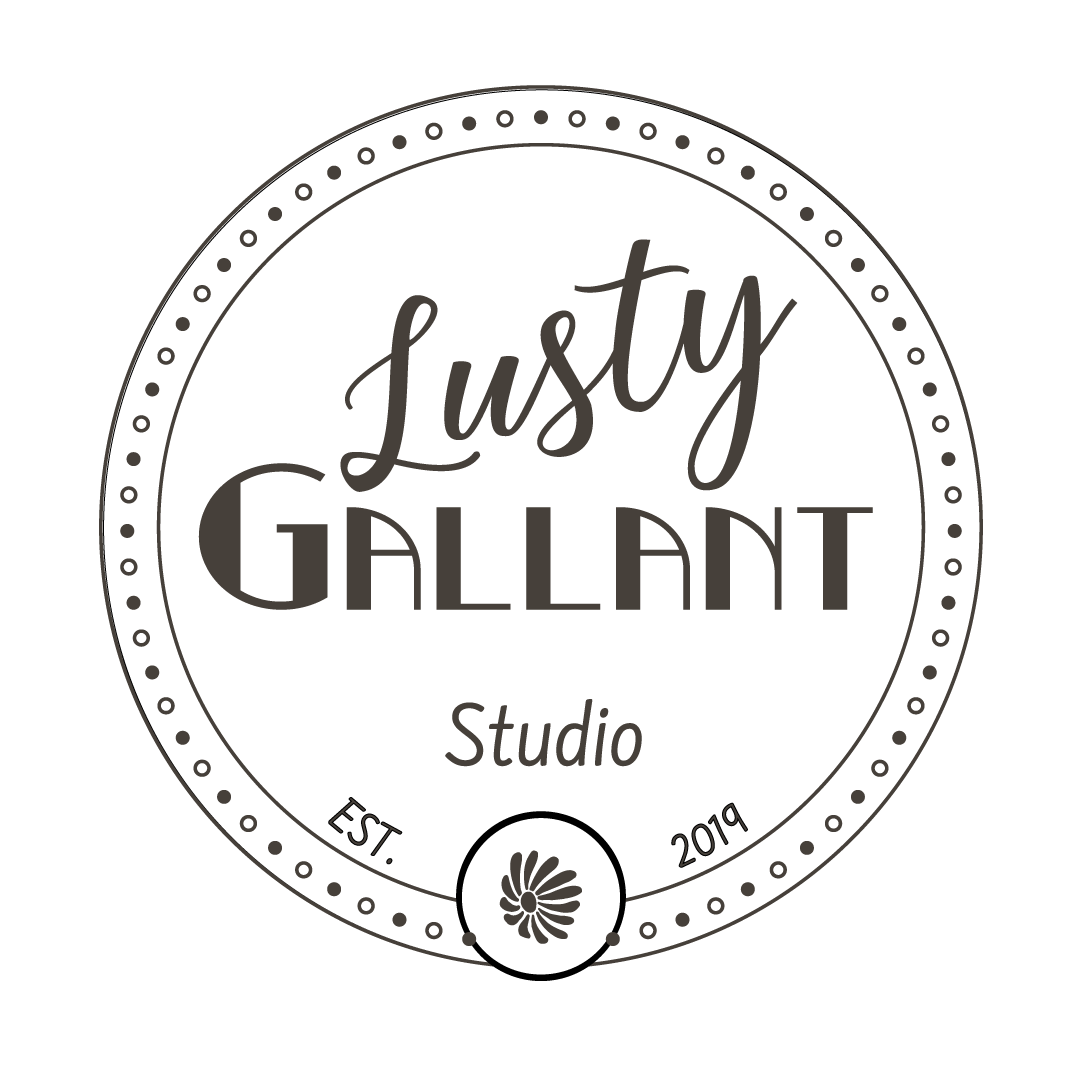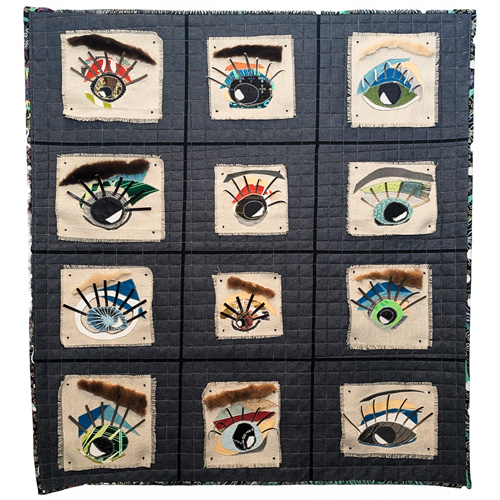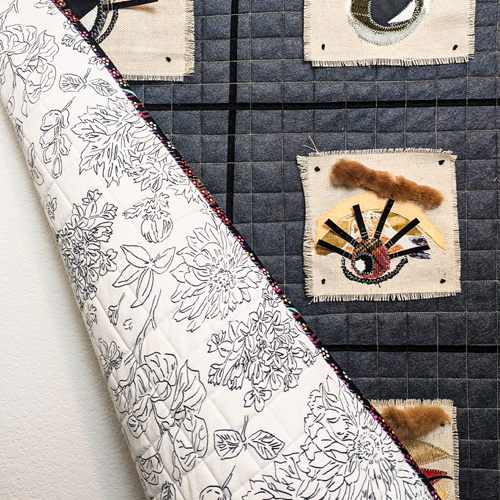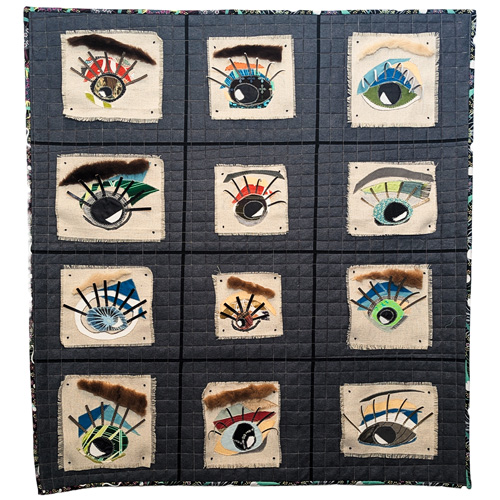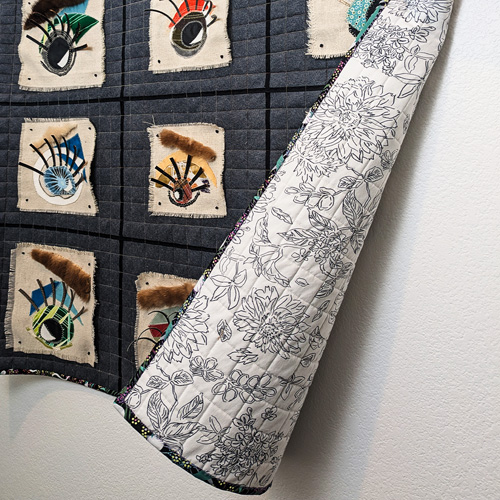Art Quilts
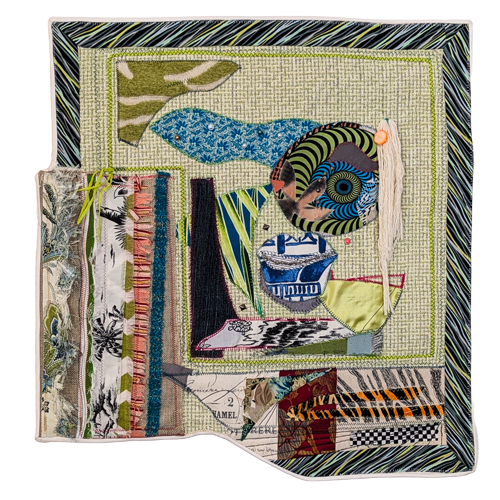
| Height | Width | Depth |
|---|---|---|
| 38″ | 36″ | 2″ |
This fiber piece explores the themes of identity, surveillance, and perception in the modern age. Each eye is an individual construction, meticulously formed from upcycled and repurposed appliqué pieces that were lovingly reworked before being stitched together into this singular, unified composition.
The materials add a compelling textural layer, incorporating elements like raw-edged burlap, vibrant fabric scraps, and soft fur that give each gaze a unique personality.
The overall structure beautifully contrasts the uniform grid quilting with the wildly expressive, complex nature of the eyes it contains. This large-scale textile work makes a profound statement about being seen and seeing others.
The Rise of the Art Quilt: From Bedding to Museum Masterpiece
Art quilts represent a vibrant, contemporary fusion of ancient textile traditions and modern artistic expression. Moving beyond their origins as utilitarian bed coverings, the art quilt has ascended to the status of fine art, challenging traditional boundaries between craft and art. Let’s explore the deep-rooted history of quilting, the evolution of the modern art quilt movement, the cultural and social significance of this medium, and the influential artists who have defined its trajectory.
The Ancient Roots of Quilting: A Global Heritage
The concept of stitching together multiple layers of fabric—a top layer, batting, and a backing—to create a warm, durable textile is a practice with a truly global and ancient history. The word “quilt” itself is linked to the Latin word culcita, meaning a bolster or stuffed sack, entering the English language in the 13th century.
-
Early Evidence: Archaeological evidence suggests quilting techniques date back over 5,000 years. An ivory carving from ancient Egypt depicts a pharaoh wearing a quilted mantle (c. 3400 BCE), and the oldest surviving quilted material, a floor covering, was discovered in Mongolia, dating from the 1st or 2nd century CE.
-
Medieval Europe: Quilting arrived in Europe around the 12th century, notably brought back by Crusaders who observed the practice in the Middle East. Initially, it served a military purpose, used for padded garments called gambesons worn under or instead of armor. It quickly transitioned to domestic use for warmth, leading to the creation of the earliest known surviving European bed quilt, the Tristan Quilt, made in Sicily in the late 14th century.
In its earliest forms, quilting was often a pursuit of the wealthy, as fine fabrics were imported and expensive, pre-dating the affordability brought by the Industrial Revolution. These elaborate pieces were frequently made for show rather than just practical warmth, decorating beds for special occasions and demonstrating the maker’s wealth and skill—a clear foreshadowing of the modern art quilt.
The American Quilt: Utility, Expression, and Social History
Quilting became a quintessential American craft, profoundly intertwined with the nation’s social and economic history.
-
Colonial and Early Republic: Early American quilts were often whole-cloth quilts, featuring a single piece of fabric on the top, with the design created entirely by the intricate, fine hand-stitching (quilting) itself. Patchwork and appliqué began to gain popularity in the late 18th century, mixing expensive imported fabrics like chintz and calico.
-
The 19th Century and Industrialization: The invention of the sewing machine in the mid-1800s and the growth of American textile manufacturing made cotton fabric more affordable. Quilting shifted from an elite art to a widely accessible and democratic one. Women from all classes participated, spurred on by the “waste-not, want-not” philosophy. Scraps of old clothing, household linens, and even feed sacks became the raw material, transforming utility into accidental folk art.
-
The Civil War Era: Quilts were used to raise funds for both sides, with abolitionists selling anti-slavery quilts and Southern women selling Gunboat Quilts.
-
-
Types of Traditional Quilts: Traditional patterns are deeply symbolic and narrate American history and life:
-
Log Cabin Quilt: Often features a red or yellow center square to symbolize the hearth or the light in the cabin window, representing home, security, and warmth to pioneers.
-
Nine Patch: One of the simplest patterns, popular for its efficiency in using small scraps, often taught to young girls as a foundational skill.
-
Double Wedding Ring: Popular in the 1930s, its interlocking rings symbolize unity and eternal love, often made as a gift for newlyweds.
-
Baltimore Album Quilt: Flounced in the 1840s and 50s, these elaborate quilts consist of many blocks, each featuring a unique, intricately appliquéd motif (often floral), frequently made as a keepsake or gift for a departing friend or minister.
-
The Birth and Evolution of the Art Quilt Movement
The distinction between a functional quilt and an artistic statement began to blur dramatically in the 20th century, leading to the formal emergence of the Art Quilt Movement in the 1960s and 70s.
The Revival and Re-Contextualization (1960s–1980s)
A confluence of cultural and social factors fueled the quilt’s re-emergence:
- Feminist Movement: The 1970s saw a renewed appreciation for fiber arts, traditionally “women’s work,” as a legitimate and powerful form of artistic expression. Artists began to embrace these techniques, challenging the patriarchal distinction between the “fine arts” (painting, sculpture) and “crafts.”
- Bicentennial Nostalgia: The United States Bicentennial in 1976 sparked a wave of interest in American folk art and traditions, bringing historic quilts out of attics and into public consciousness and museums.
- Museum Recognition: Groundbreaking exhibitions, such as the 1971 show Abstract Design in American Quilts at the Whitney Museum of American Art, presented quilts not as domestic relics but as major examples of abstract art, influencing a new generation of artists.
The resulting art quilt transcended the square block format and functional constraints. Artists began utilizing the medium to explore abstract design, narrative storytelling, political commentary, and photographic realism, employing techniques like surface design, painting on fabric, and unconventional materials.
The Art Quilt Today: Exhibitions and Globalization
The evolution of the art quilt has been inextricably linked to the establishment of major quilt shows and organizations that provide critical validation, exposure, and community.
-
Quilt National: Established in 1979 in Athens, Ohio, this biennial exhibition is arguably the most prestigious showcase for contemporary art quilts, dedicated exclusively to the quilt as an art object. Acceptance into Quilt National is a major career milestone for art quilters globally.
-
The Studio Art Quilt Associates (SAQA): Founded in 1989, SAQA is a non-profit organization dedicated to promoting the art quilt as a fine art medium. It plays a crucial role in curating traveling exhibitions, defining the art quilt (often as a stitched textile work that expresses aesthetic concerns more than utility), and building connections between artists, curators, and collectors worldwide.
-
Houston International Quilt Festival: While featuring traditional quilts, this massive annual event also dedicates significant space to contemporary and art quilt exhibits, serving as a huge commercial and cultural hub for the global quilting community.
These venues have solidified the art quilt’s place in the broader art world, allowing artists to command serious recognition and prices, often selling their non-functional wall hangings to galleries and private collections.
Iconic Figures in Art Quilting
The art quilt movement boasts many influential figures who have pushed the medium’s technical and conceptual boundaries.
-
Faith Ringgold (1930–2024): Arguably the most famous art quilter, Ringgold’s work, known as painted story quilts, seamlessly combines painting, traditional quilting, and narrative storytelling to explore themes of race, gender, and history. Her iconic work, Tar Beach (1988), which is in the collection of the Solomon R. Guggenheim Museum, is a masterpiece of this genre.
-
Harriet Powers (1837–1910): A 19th-century African American folk artist, her surviving quilts, like the Bible Quilt and the Pictorial Quilt, are crucial historical documents. They feature appliqué designs that narrate local historical events, biblical stories, and astronomical phenomena, demonstrating the early power of quilting as a form of visual literacy and historical record.
-
Yvonne Porcella (1936–2016): A key figure in the mid-to-late 20th-century movement, Porcella was known for her vibrant, abstract designs and bold use of color, which helped to break away from traditional geometric patterns.
-
Bisa Butler (born 1973): A contemporary artist who has achieved international acclaim, Butler creates magnificent, life-sized quilted portraits, often of African American figures from history. Her signature style uses richly patterned, meticulously cut, and layered fabrics to render skin, clothing, and background, giving her subjects a regal, three-dimensional quality that has captivated critics and collectors alike.
-
Nancy Crow (born 1943): Known for her large-scale, powerful geometric and improvisational abstract quilts, Crow is a technical master who has had a significant impact on the teaching and development of contemporary quilt design.
The Deep Value of Art Quilts: Historical, Social, and Cultural
Art quilts, regardless of whether they are traditional or avant-garde, are deeply meaningful objects that offer unique historical and cultural value.
Historical and Social Record
Quilts are often referred to as textile documents or soft history.
-
Personal and Family Narrative: Quilts made from scraps of old clothes preserve family history, turning worn-out garments into tangible memories of loved ones and specific life events.
-
Community and Collaboration: The tradition of the Quilting Bee—where women gathered to collectively stitch a quilt—underscores the importance of the medium for fostering female community, shared labor, and social bonding. Quilts made for weddings, births, or as farewell gifts (e.g., Album Quilts or Signature Quilts) mark significant life passages.
-
Agency and Subversion: Historically, particularly among enslaved African American women, quilting provided a rare creative outlet and a means of cultural preservation and communication when literacy was denied. Quilts from the Gees Bend, Alabama, community, for example, have received widespread acclaim for their radical, improvisational use of color and geometry.
Cultural and Artistic Significance
The art quilt’s cultural value lies in its ability to elevate a domestic craft to high art while simultaneously telling powerful stories.
-
Challenging Artistic Hierarchy: Art quilts continually challenge the established hierarchy that places painting and sculpture above fiber art. By adapting the medium to contemporary aesthetic and conceptual concerns—such as political protest, environmental issues, and personal identity—they force a re-evaluation of what constitutes fine art.
-
Tactility and Materiality: Unlike flat mediums, the quilt is inherently tactile and dimensional. The quilting stitches themselves, which create texture and relief, add a layer of drawing or mark-making that is unique to the medium. This emphasis on process and materiality is a core strength of modern fiber art.
The journey of the quilt from a humble bed cover, made from necessity on the American frontier, to a sophisticated form of artistic expression displayed in major museums, is a profound statement about the enduring power of textiles. The art quilt, utilizing ancient techniques with a contemporary vision, remains a dynamic and significant force in the global art world.
